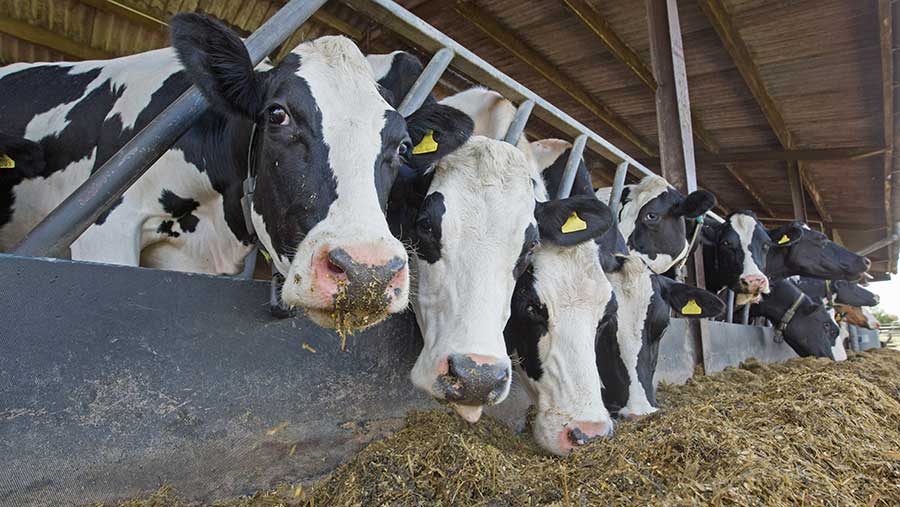Glossary: How to understand terms used in dairy fertility data
 © Tim Scrivener
© Tim Scrivener There’s a bewildering array of terms used for benchmarking fertility. As data becomes more important in achieving efficiency, many of the words and phrases used may be misinterpreted or are not properly understood.
Vet Tonia Simms unravels key breeding terms and the numbers behind them in this glossary.
Oestrus
Oestrus is the point of the reproductive cycle when a cow is said to be in heat, is receptive to the bull, will ovulate, and can therefore be served.
In a healthy cow, this should occur every 20-24 days. There are various KPIs associated with a cow’s heat:
Voluntary waiting period (VWP)
This is the period of time after calving when farmers refrain from breeding cows even if they show heat because they require time to complete normal uterine involution.
Eligible animals
Cows that are past the VWP or start of the breeding period, which are not pregnant and have not been put on the barren list.
Heat detection rate (HDR)
The percentage of eligible females that are actually seen or detected in heat. In a perfect system, this would be 100%.
See also: How to prevent fertility issues caused by lameness
Submission rate (SR)
The percentage of eligible females that are served in a given period, normally during one oestrous period (three weeks). So, as the cows pass the VWP, are they being served?
Calving to first service interval
The time, in days, from calving to when the animal is served for the first time. Ideally, for each cow, this should be within one oestrus period of the VWP, so on average it should be within approximately 12 days after VWP.
Inter-service interval
The time, in days, between two services or oestrous events in an individual cow. Most cows should fall between 20 and 24 days. If this period increased it may indicate lost pregnancies or poor heat detection.
Conception
Conception is the act of becoming pregnant through fertilisation and implantation of the fertilised egg onto the lining of the uterus.
For a KPI based on conception to be measured, the cow must be diagnosed as pregnant.
Conception rate (CR)
This is the number of inseminations it takes to achieve a pregnancy. E.g. if it takes on average 2 serves for a cow to conceive, the conception rate is 50%. Take care not to confuse this with “pregnancy rate”, which has various definitions, so clarification is needed before interpretation.
Calving to conception interval
This is the time, in days, from calving to the point of conception, so takes into account the voluntary waiting period, the heat detection rate and the submission rate.
100 day in calf rate
The number of cows that are in calf by 100 days as a proportion of the total number of cows. This KPI takes into account of heat detection, submission and conception rate. In a herd with an extended lactation curve, 120 days may be more appropriate.
Calving interval
Traditionally this has been a historic number based on the time in days between two calvings. Therefore, it only allows analysis of the fertility of the herd a year ago. Recently, data programs have started to calculate this figure prospectively, based on the calving to conception interval and the average gestation period of 280-282 days, making it a more useful figure.
Composite KPIs
Composite KPIs are normally based over a 21 day period and allow a more up to date analysis of the herd’s fertility. They may rely on a pregnancy diagnosis, but this can be performed by your vet from around 28 days after service. The data is much more current allowing rapid alterations in management if problems arise.
Preg Rate (PR)
This can also be known as Reproductive Efficiency. It is an American KPI that is rapidly being adopted in the UK. It’s the product of HDR/SR and CR. For example, in a herd, if 50 animals are eligible in one 21 day period: 40 are inseminated (40/50 = 80% SR); 20 of those cows become pregnant (20/40 = 50% CR).
For this 21 day period the PR is 20 pregnant cows from 50 eligible cows or 40%. When discussing PR, ensure that the term is defined before interpretation.
Tonia Simms BVSc DBR MRCVS
RCVS Advanced Practitioner in Bovine Reproduction
Tonia grew up in Knutsford, Cheshire surrounded by dairy cows. She graduated from Bristol University in 2007 and went straight into farm animal practice and is now a practice principal for Westpoint Farm Vets in Leighton Buzzard and Clinical Lead for Westpoint’s Fertility and Genetics Working Group.
Tonia is particularly interested in a holistic approach to production medicine – particularly with regards to fertility.
She is currently a holder of the Diploma in Bovine Reproduction and is an RCVS Advance Practitioner in Bovine Reproduction.
